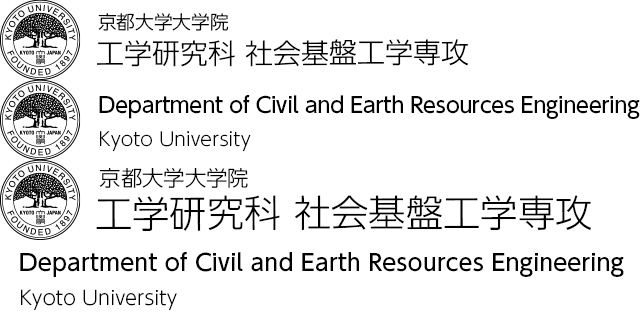Measurement and Evaluation Technology
Resource, energy and waste issues are essential for humans to maintain decent social life styles or even to survive. The earth resources and fossil energy are limited and, thus, will be subjected to exhaustibility in the future. Countermeasure has to be put into action as promptly as possible. However, no such alternative energy is available at present, and nuclear energy generates radioactive waste which will require an extremely long-term management. It is still a long way for new techniques or discoveries to conquer this problem. We need to take advantage of resources that are currently available.
In our laboratory, based on the measurement techniques, relevant research field covers but not limited to:
-
Exploring (developing) the competent techniques to effectively and intentionally increase the exploitability of earth resources and energy;
-
R&D for disposing of bi-products resulting from production of energy etc. (radioactive waste or carbon dioxide)
-
Developing the non-destructive testing and evaluation (NDT&E) techniques to efficiently manage and utilize the resources which had been exploited already.
Academic Staff
Sumihiko MURATA
Professor (Graduate School of Engineering)
Research Topics
Fossil energy resources, such as oil and natural gas, and various mineral resources are necessary for current our life. Therefore, the technologies and engineering methods to develop these natural resources eco-friendly and supply them sustainably are desired.
My research themes are as follows: 1) Development of efficient and eco-friendly enhanced oil and gas technology (EOGR), 2) Enhancement of carbon capture and storage (CCS) especially for carbon dioxide whose origin is fossil energy resources, 3) Development of eco-friendly mining technology such as the reduction of blasting vibration and infrasound, stabilization of the large-scale rock slope by mining, and mine reclamation.
Contacts
Room 352, Bldg. C1, Katsura Campus
TEL: +81-75-383-3215
FAX: +81-75-383-3218
E-mail: murata.sumihiko.6v kyoto-u.ac.jp
kyoto-u.ac.jp
Kazuya KOBAYASHI
 Assistant Professor (Graduate School of Engineering)
Assistant Professor (Graduate School of Engineering)
Research Topics
For efficient recovery of oil and gas and underground storage of carbon dioxide, it is necessary to understand the flow that occurs in pore spaces.
Interactions at the interface between minerals, brine, oil/gas, and carbon dioxide have a significant impact on this flow. I investigate this interaction using tools with molecular resolution.
Contacts
Room 351, Bldg. C1, Katsura Campus
TEL: 075-383-3216
FAX:
E-mail: kobayashi.kazuya.6w kyoto-u.ac.jp
kyoto-u.ac.jp
Research Topics
Experiment and simulation of innovated NDT&E
It is difficult for the conventional NDT&E to detect the flaw/defect sensitively and accurately due to the lack of satisfied resolution. To overcome this problem, some innovated NDT&E techniques are under developing.
Total magnetic flux method for wire rope flaw detection
For the testing targets with long axis, such as wire rope, suppose to be longitudinally saturated by a strong magnetic field, the external magnetic flux leakage (MFL) is well proportional to the internal flaw content. Based on this scheme, precise defect detection and characterization can be achieved. Design of this NDT system and the improved signal processing algorithm consist one of the research activities. ( Figure 1 )
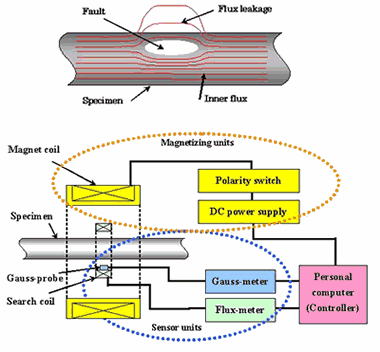
Figure 1: Illustration of the relation between flaw and MFL (top part), and schematic of total-magnetic-flux-based measurement system (bottom part).
Magnetostrictive ultrasonic method for wire rope flaw detection
Ultrasonic inspection are one of the popular NDT&E methods for internal flaw detection. However, it performs poor when the ultrasonic transducer can not be directly installed. This problem can be avoided by using the magnetostrictive ultrasonic NDT method if the target to be tested has high magnetism. One example is shown as Figure 2.
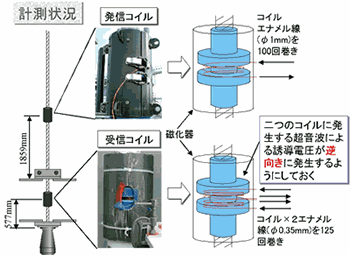
Figure 2: Schematic of measurement system based on magnetostrictive ultrasonic NDT method
Capacitance array probe used for flaw detection of dielectric materials
Polymer composite are popularly used as the substitute of metal recently. NDT&E techniques for composite are strongly desired. To meet this demand, capacitance array probe (CAP) method is proposed for flaw detection based on the property of dielectric constant variance (difference). Figure 3 gives an example of CAP application.
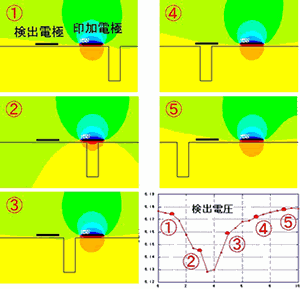
Figure 3: Electrical potential distribution of the near-flaw area and detected voltage (bottom-right part)
Fundamental research on NDT&E techniques
In addition to the development of innovated NDT&E, it is necessary to improve the conventional techniques by designing sensitive and precise NDT&E system and integrating advanced signal processing algorithms. Aiming at this objective, relevant research activities are carried out, including but not limited to:
Study on initial variable estimation and solution to the inversion problem
The internal conductivity distribution of the material to be tested can be estimated from the electric potential when current propagates inside the material. However, the relation between them is nonlinear. The reliability of the inversion solution mostly depends on the initial model. In our laboratory, relatively simpler methods are being developed to build an effective initial model. Figure 4 presents such an example.
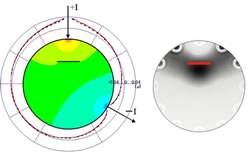
Figure 4: An example: Electrical potential distribution of a circular-shape plate with one crack and its image obtained by Back-projection method.
Study on precise measurement and evaluation of ultrasonic wave velocity dispersion
To detect and characterize the internal flaw, ultrasonic wave performs better that most other wave techniques do. Therefore, it is important to well understand the various properties of wave, especially the relation between frequency and propagating velocity. This consists one of the current research sub-field.
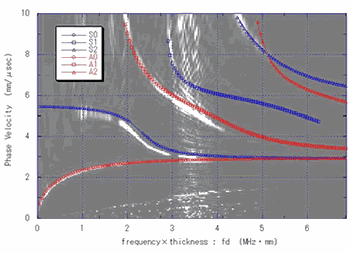
Figure 5: Experimental result of the relation between frequency and propagation velocity of various Lamb waves, and the theoretical computation.
Study on signal processing and fusion based on multiresolution analysis (MRA) method
No single NDT method can fully assess the structural integrity of a material. The use of more than one NDT techniques can capture better understanding and result. Information of interest from different data sources distribute at different resolution levels. By multiresolutionally decomposition, the dominant features from various source data are highlighted at corresponding sales, so that data fusion can be applied to achieve a more precise interpretation and characterization of the material. Figure 6 gives an example of multifrequency eddy current fusion result of a specimen with two cracks in both surfaces.
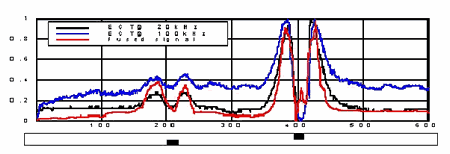
Figure 6: Data fusion result from multi-frequency eddy current testing for a plate with two cracks in both surfaces.
Studies on operating and management system development for large-scale transportation machine
Monitoring system for long and massive winding machine used for inclined shaft (Figure 7)
Inclined or vertical shafts act as the necessary access to exploit the underground earth resources and to utilize the underground environment. Wire rope is used by nearly all of the massive winding machine. One of our research fields is carried out to build the management and monitoring system for such a massive machine.
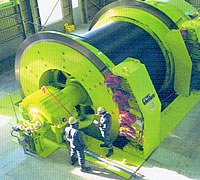
Figure 7: The worldwide longest winding machine for inclined shaft with length of 7,000m. (provided by Kusio Colliery )
Analysis on dynamic behaviour of wire ropes in aerial ropeway.
Ropeway plays a very popular and important way for mountain transportation. However, there are multifarious ropeway systems in different geographical conditions. At the present time, the design and management of ropeway are made on basis of the knowledge obtained only from experience. As one research sub-field in our laboratory, a simple method for calculation of equilibrium state of wire rope system in aerial ropeway has been proposed. And the simulation model of cabin oscillation coupled with wire ropes is also under development.
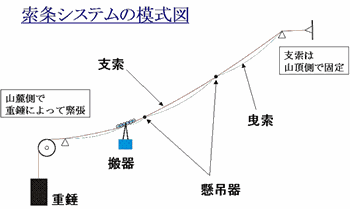
Figure 8: Simulation model for cabin oscillation coupled with ropes in aerial ropeway.
Study on rock blasting and breaking
To break the rock is necessary for tunnel excavation and underground environment utilization. Explosive blasting or mechanical tunnel excavator are popularly adopted. Recently for small scale construction, non-expansive demolition agents are used to break the rock or concrete structure. Efficient implementation scheme for such methods is also studied in our laboratory.
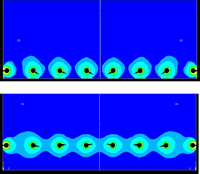
Figure 9: Distinction illustration for the potential crack developing direction from the bore holes: near-block end (top part) and far-block end (bottom part).
